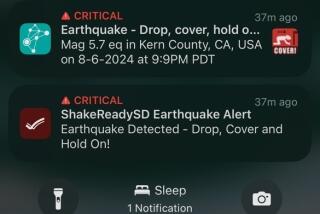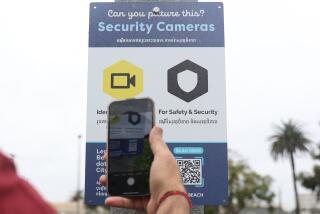Audio sensors pinpointing gunshots show San Diego police that only 25% are reported by residents
Reporting from San Diego — San Diego police installed audio sensors that detect gunfire in four neighborhoods last November, and the first batch of data shows that only one in four shootings were reported to police.
Of 61 shootings, 26% were called in by residents, according to data collected by the system called ShotSpotter.
The sensors were installed in Valencia Park, Lincoln Park, Skyline and O’Farrell. Most of the “activations” between Nov. 26 and March 27 included multiple gunshots, and nearly all of them happened at night — many between 9 p.m. and midnight.
San Diego Police Chief Shelley Zimmerman said the early data seem to confirm what officers have heard from residents: They’re afraid to reach out to police for fear of retaliation.
“ShotSpotter has given a voice to the voiceless,” she said.
But community leaders critical of the system said the network has done little to give voice to residents, most of whom weren’t included in any talks about the technology.
“It’s almost like [this technology] is being shoved down the community’s throat.” said Bishop Cornelius Bowser of Charity Apostolic Church. “It tells the community, ‘We know what’s best for you’ rather than letting the community tell [the department] what they need,” he said.
The audio equipment is placed at least 30 to 40 feet above street level to determine when and where shootings take place. Once the sensors pinpoint where the gunshots came from, the sound is sent to a review center where a specialist determines if it was gunfire.
The review center is staffed by employees of SST Inc., the company that sells ShotSpotter, not the police department.
If the sound is determined to be gunfire, the incident is forwarded to police. Officers in the field get the location, time of the shooting and the number of rounds fired. They also can get information such as how many shooters are present and if they’re on the move.
The technology is used in more than 90 cities worldwide including New York, Oakland and Miami.
Zimmerman said the system has informed officers of shootings they never would have known about, and allowed them to respond more quickly and accurately to ones the community did call in.
They’re able to swoop in on evidence left at the scene and, in one case, it led officers to a weapon used in a killing and several home invasion robberies. In another instance, officers got to the scene so fast a teenager who fired his gun didn’t have time to get rid of it and was arrested.
“What we want to be is proactive,” Zimmerman said, “and send a message that if you’re going to fire a gun in our neighborhoods, we’re going to do everything that we possibly can to prevent that.“
And if we can’t prevent it, to take you into custody as quickly as we can.
”When the technology was first unveiled, San Diego community leaders were concerned that it was installed with little to no input from residents living in those neighborhoods. They also worried it would contribute to the over-policing of communities of color.
Those concerns persist, said Bowser, who is also a member of the Black Advisory Board to the San Diego Police Department.
Bowser partnered with the department to combat gang violence nearly a decade ago, and he helped shape the Community Assistance Support Team to stop retaliatory gang violence.
Over the years, he said, he has seen how effective community policing initiatives can be in trying to diminish violence and create strong ties with the community.
Bowser said he doesn’t feel ShotSpotter is a system that will help build partnerships, in part because of how little the community was involved in the implementation, he said.
“This should have been something the community wanted, not just something the police wanted,” Bowser said.
Invasion of privacy is also a concern, he said.
Although the system isn’t designed to pick up conversation, there have been instances in which conversations immediately following shootings have been used in court.
In one case, an Oakland man’s dying words were used as evidence against his suspected killer.
Chief Zimmerman said it was too early to say whether the department will keep or expand the year-long program. It cost $245,000 and was paid for through asset forfeiture funds.
Winkley writes for the San Diego Union-Tribune.
More to Read
Sign up for Essential California
The most important California stories and recommendations in your inbox every morning.
You may occasionally receive promotional content from the Los Angeles Times.










